Identification of the Genetic Materials Introduction
When it became evident that the chromosomes were the organs of heredity because they formed the only link between two generations, they carried linearly arranged genes, they occurred in every organism in specific numbers and had specific morphology for a particular species.
Any variation in their morphology affected the phenotype of the species, then, various attempts were made by early molecular geneticists to identify the physical and chemical nature of genes. But the genes were found so minute structures that their physical identity remained almost impossible.
- However, the extensive chemical analysis of chromosomes of different organisms has revealed that chromosomes contain proteins and nucleic acids (DNA and RNA), and it was thought that genes might have either proteins or nucleic acids as their component molecules.
- Early molecular geneticists have assigned the informational roles of genes to the chromosomal proteins because they found nucleic acids too simple to carry genetic information. (This is called the tetranucleotide hypothesis).
- The controversy about the assignment of genetic roles either to chromosomal proteins or to chromosomal DNA, existed up to 1949 when A. Mirsky and H. Ris found that all cells of an organism appeared to contain the same amount of DNA, whereas different cell types contained quite different amounts and kinds of protein.
- Its constancy, therefore, favoured DNA as the genetic material. Around 1953, it was universally accepted that DNA is the genetic substance (chemical of which genes are composed); of most microorganisms and higher organisms.
- Later on, RNA was found to be the genetic material of some viruses. The concept that DNA or RNA is the genetic material of most organisms has been developed and supported by the following evidence:
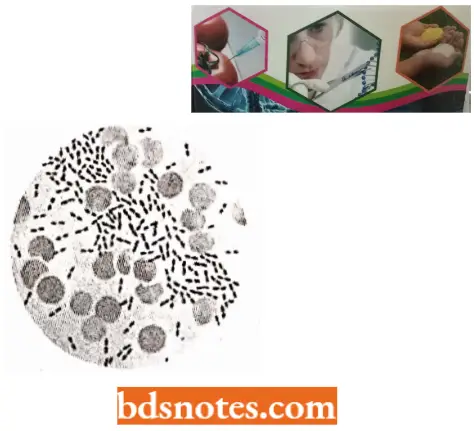
Direct Evidence For DNA as The Genetic Material
The most conclusive evidence in support of DNA as the genetic material came from the following three avenues of approach on microorganisms: transformation of bacteria, mode of infection of bacteriophages and conjugation of bacteria.
The Transformation Experiments: In 1928, Frederick Griffith encountered a phenomenon now known as genetic transformation. Colonies of a virulent strain (pathogenic) of pneumonia-causing bacterium, Diplococcus pneumoniae grown on nutrient agar, have a smooth (S) glistening appearance owing to the presence of a type-specific, polysaccharide (a polymer of glucose and glucuronic acid) capsule.
- The avirulent (nonpathogenic) strains, on the other hand, lack this capsule and they produce dull, rough (R) colonies.
- Smooth (S) and rough (R) characters are directly related to the presence or absence of the capsule and this trait is known to be genetically determined. Both S and R forms occur in several types and are designated as S-1, S-2, S-3, etc., and R-1, R-2, R-3, etc., respectively. All these subtypes of S and R bacteria differ from each other in the type of antigens, they produce.
- The kind of antigen produced is likewise genetically determined. Smooth (S) forms sometimes mutate to rough (R) forms, but this change has not been found reversible.
- In the course of his work, Griffith injected laboratory mice with live R-2 pneumococci; the mice suffered no illness because R-2 pneumococci was avirulent. But, when the mice were injected with virulent S-3 pneumococci, the mice suffered from pneumonia and died.
- However, when he injected the heat-killed S-3 bacteria in mice, they did not suffer from pneumonia. But, when the mice were injected with the mixture of living avirulent R-2 and heat-killed S-3 virulent, the unexpected symptoms of pneumonia appeared and high mortality resulted.
- By postmorteming the dead mice, it was found that their heart blood had both R-2 and S-3 pneumococci. From these results, Griffith concluded that the presence of the heat-killed S-3 bacteria must have caused a transformation of the living R-2 bacteria, to restore to them the capacity for capsule formation they had earlier lost by gene mutation. This was called the “Griffith effect” or more popularly “bacterial transformation”.
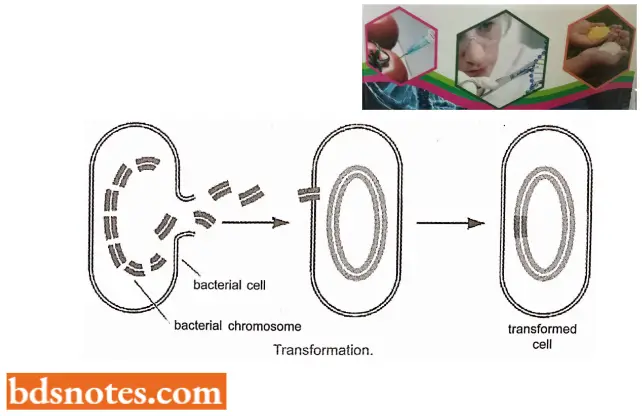
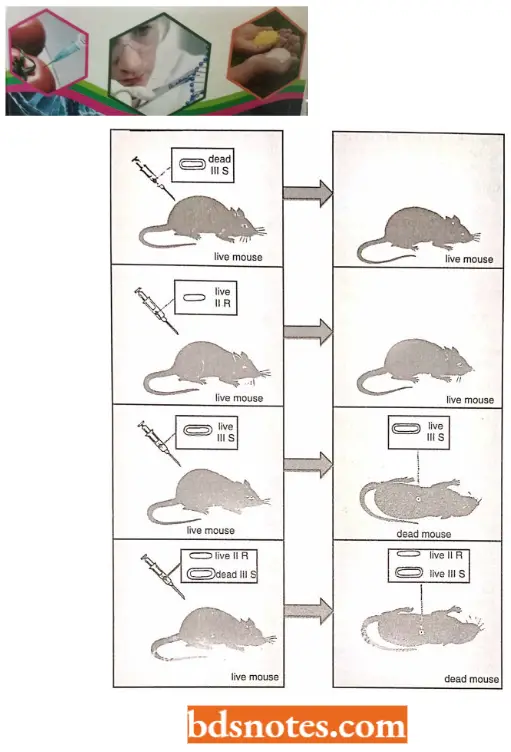
- Identification of the “transforming principle or substance”. Griffith could not understand the cause of bacterial transformation and that was first identified by Oswald Avery, Colin MacLeod and Maclyn McCarty (1944).
- They partially purified the transforming principle from the cell extract (i.e., cell-free extract of S-3 bacteria) and demonstrated that it was DNA. These workers modified the known schemes for isolating DNA and prepared samples of DNA from S-3 bacteria. They added this DNA to a live R bacterial culture; after some time they placed a sample of S-3 containing R-2 bacterial culture on an agar surface and allowed it to grow to form colonies.
- Some of the colonies (about 1 in 104) that grew were S-3 type. To show that this was a permanent genetic change, they dispersed many of the newly formed S-3 colonies and placed them on a second agar surface. The resulting colonies were again S-3 type.
- If an R-2 colony arising from the original mixture was dispersed, only R-2 bacteria grew in subsequent generations. Hence, the R-2 colonies retained the R-2 character, whereas the transformed S-3 colonies bred true as S-3.
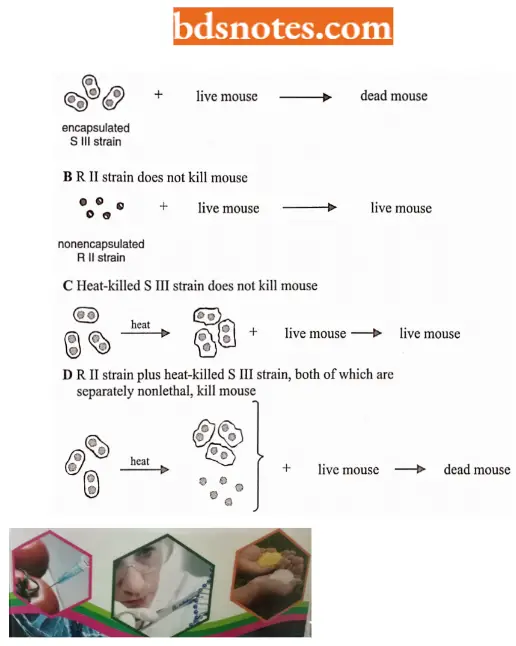
Further, because S-III and R-II colonies differed by a polysaccharide coat around each S-III bacterium, the ability of purified polysaccharide to transform was also tested, but no transformation was observed. The evidence that the extracted transforming principle contains DNA, was provided by the following four methods:
- Chemical analysis showed that the major component was deoxyribose containing nucleic acid.
- Physical measurement showed that the sample contained a highly viscous substance having the properties of DNA.
- Experiments demonstrated that transforming activity is not lost by reaction with either (a) purified proteolytic (protein-hydrolyzing) enzymes trypsin, chymotrypsin, or a mixture of both or (b) ribonuclease (an enzyme that depolymerizes RNA). The lipase too has no effect.
- It was demonstrated that the treatment with materials, known to contain DNA depolymerizing activity (DNAase enzyme), inactivated the transforming principle. Later on, such a transforming substance, the DNA, was found in a variety of bacteria (for example., Hemophilus influenzae, Bacillus subtilus, Shigella paradysenteriae, etc.) and several other organisms.
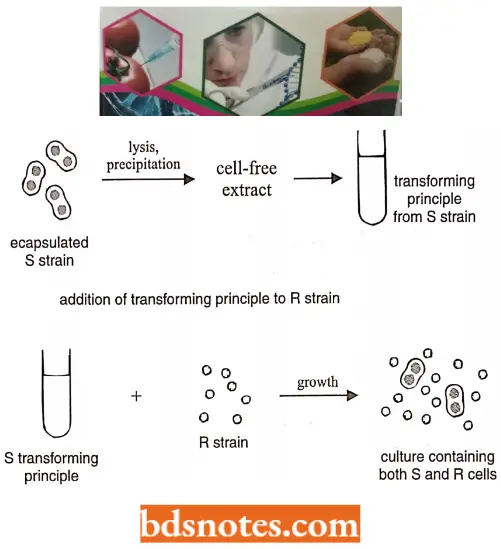
The Blender Experiment: An elegant confirmation of the genetic nature of DNA came from an experiment with E. coli phage T2. This experiment known as the blender experiment because a kitchen waring blender was used as a major piece of apparatus, was performed by Alfred Hershey and Martha Chase in 1952.
- They demonstrated that the DNA injected by a phage particle into a bacterium contains all the information required to synthesize progeny phage particles. A single particle of phage T2 consists of DNA (now known to be a single molecule) encased in a protein shell.
- The DNA is the only phosphorus-containing substance in the phage particle; the proteins of the shell, which contain the amino acids methionine and cysteine, have the only sulphur atoms. In these experiments, phage DNA was made radioactive by growing infected bacteria on a medium containing radioactive phosphate (32PO4).
- Since phage proteins do not contain phosphorus, only DNA would be labelled. Similarly, phage proteins were labelled with the help of 35SO4. Since DNA does not contain sulphur, only protein would be labelled with 35S. Such differential labelling would enable one to distinguish between DNA and proteins of the phage without performing any chemical tests.
- Hershey and Chase then allowed both kinds of labelled phage particles to infect E. coli bacteria). The infected bacteria were immediately agitated in a waring blender. After shaking, only radioactive 32P was found associated with bacterial cells and 35S was found only in the surrounding medium and not in bacterial cells.
- When phage progeny was studied for radioactivity in this experiment, it was found that the phage progeny carried labelled only 32P. The progeny was not labelled with 35S.
- This indicates that only DNA and not protein is injected into bacterial cells. The empty protein coat (ghost) is left outside. Thus, Hershey and Chase’s experiment proved that DNA entering the host cell carries all the genetic information for the synthesis of new phage particles and, hence, is the sole genetic material in DNA bacteriophages (for example T2).
Bacterial Conjugation: Another conclusive evidence for DNA as the genetic material came from the phenomenon of conjugation of bacteria. Laderberg and Tatum (1946) found that when an F+ (‘male’) E. coli cell conjugated with an F– (‘female’) E. coli cell, unidirectional transfer of F+ factor of the male cell to F– or ‘female’ cell took place so that the latter was found to be a fragment of DNA molecule which occurred in the cytoplasm of the bacterial cell.
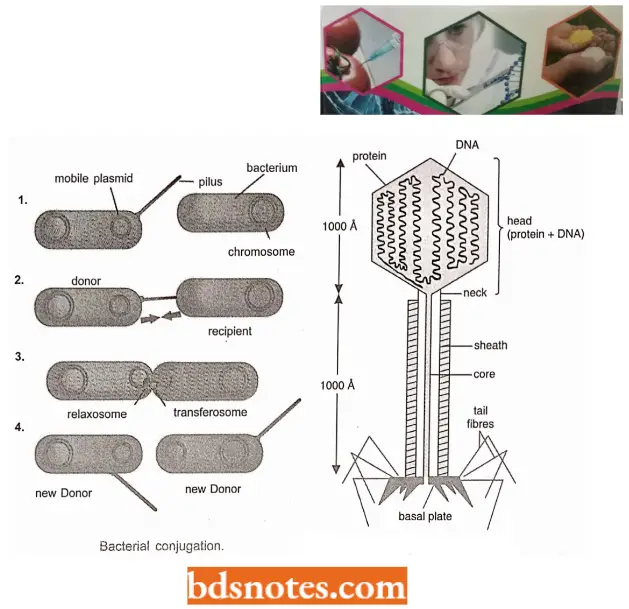
Indirect Evidence For DNA as The Genetic Material
The indirect evidence in favour of DNA as the genetic material came from higher organisms which are not as easy to manipulate as bacteria and viruses. The fact that DNA is the genetic material of higher organisms has been supported by the following facts:
The Feulgen techniques have shown that DNA entirely remains restricted to the chromosomes and it forms one of the major components of chromosomes.
DNA Content And Ploidy:
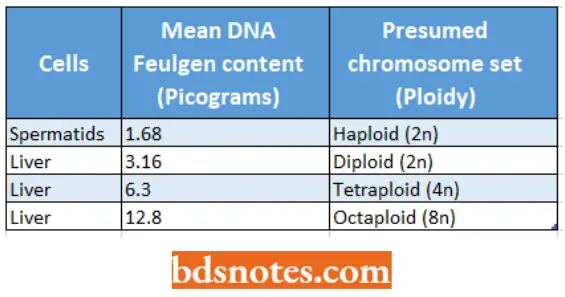
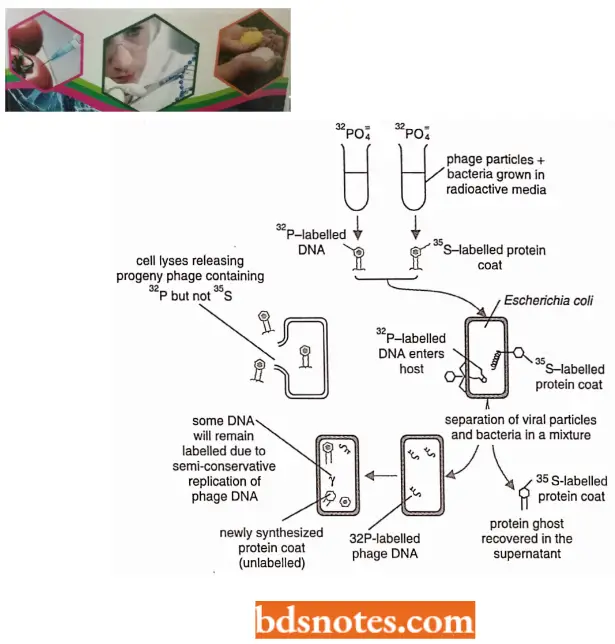
Various quantitative measurements of the amount of DNA in different cells have shown that there is a correlation between the amount of DNA and the number of chromosome sets (ploidy).
DNA Contents In Picograms (gram × 10-12) Of Various Cells:
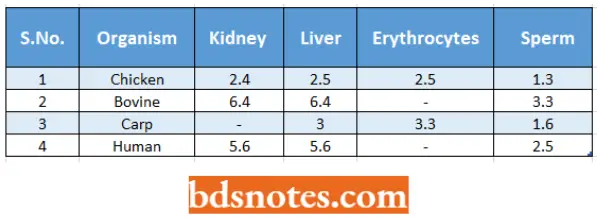
- The diploid amount of DNA is constant within the species but varies from one species to another, as shown in the Table.
- In 1950 Swift found the amount of DNA per resting nucleus (interphase nucleus) in mitotically active tissues of animals ranged from twice (2n) the value found in the gametes (In) to four times (4n) this value. He concluded that DNA synthesis occurred during the interphase.
- This parallelism of behaviour in DNA and chromosomes indicates that DNA is the genetic material of higher animals.
Evidence For RNA As The Genetic Material Of Some Viruses
The demonstration that RNA is the genetic material in RNA – RNA-containing viruses came in 1956 when A. Gierer and G. Schramm showed that tobacco plants could be inoculated with purified RNA from the tobacco mosaic virus (TMV), and TMV-like lesions could later be identified on the tobacco leaves. A different approach was taken by H. Fraenkel-Conrat and B. Singer in experiments published in 1957.
- They first developed the techniques for separating TMV particles Into RNA and proteins, Lnlor hy using RNA and proteins separately in tests for infectivity, it was shown RNA alone was able to cause infection.
- They then developed techniques for forming “reconstituted” viruses containing the protein from one mutant strain of TMV and RNA from another, or vice-versa, Such hybrid viruses (or chimeras) were allowed to infect tobacco leaves, and the progeny were examined. In all cases, the progeny were the parental RNA type and not the parental protein type.
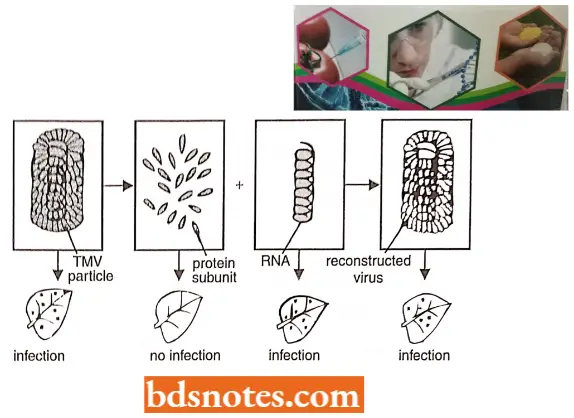
- In another experiment were used two different types of RNA viruses, namely TMV (tobacco mosaic virus) and HRV (Holmes rib-grass virus). The latter is also called the Plantago strain since this virus was isolated from Plantago lanceolata.
- Proteins of these two viruses differ in having different frequencies and sequences of amino acids. Also, these viruses give different symptoms on leaves of a particular variety of tobacco, while TMV produces mottling of leaves, HRV produces distinct ring patterns.
- Reciprocal chimaeras using RNA of one strain and protein of another strain were obtained. It was found that when these chimaeras were used for infection, the progeny had proteins which corresponded to the virus from which the RNA of the infecting virus particle was derived.
- This proved that the specificity of virus proteins was determined by RNA alone and that proteins carried no genetic information.
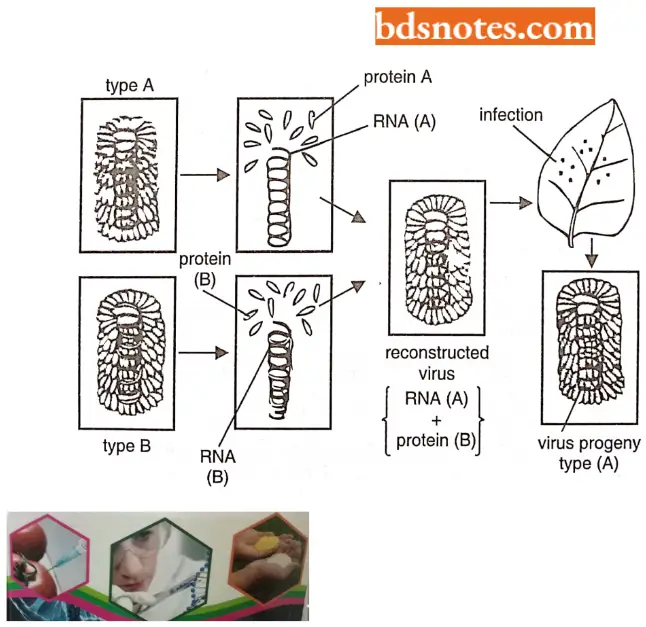
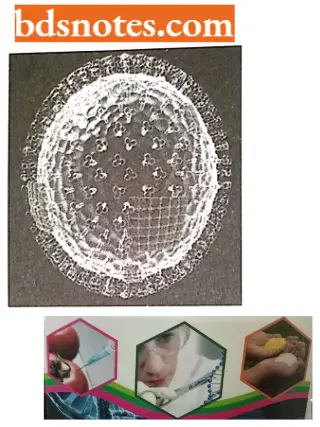
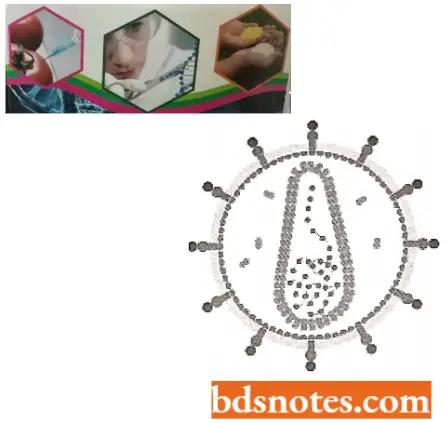
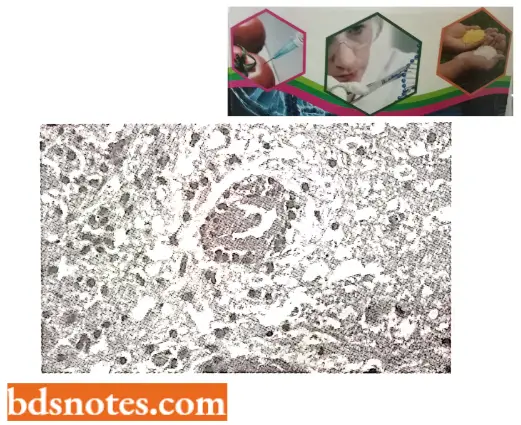
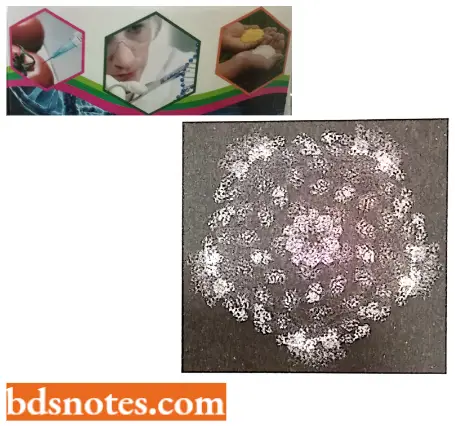
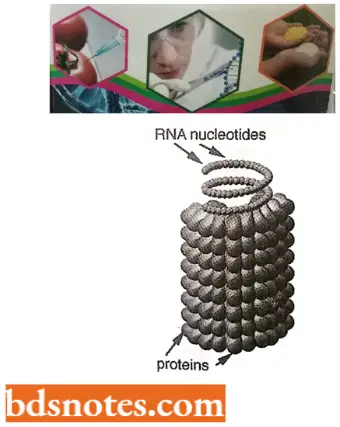
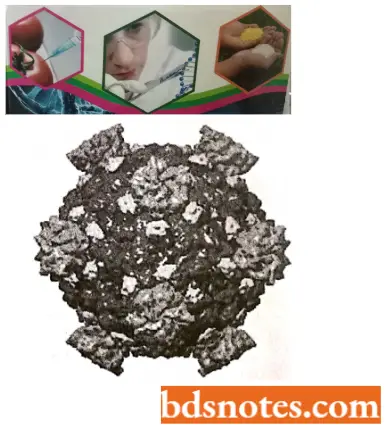
- In a much improved technique N. Pace and S. Spiegelman in 1966 purified RNA from two different mutant strains of the RNA Phage QB which had quite distinct base compositions. The isolated RNAs were then incubated separately in the presence of an E. coli cell extract containing an enzyme capable of RNA replication.
- The new RNA synthesized was in each case identical in base composition to the particular phage RNA presented to the in vitro system, thus, indicating that the phage RNA can serve as a template for its self-replication. The genetic RNA is found to be either single-stranded or double-stranded.
Different RNA viruses and the nature of genetic RNA associated with them:
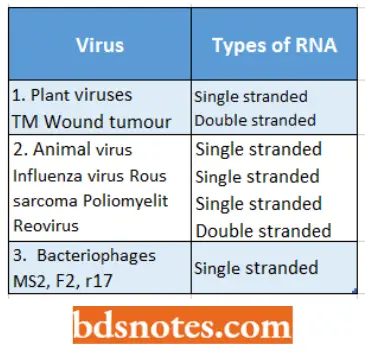
Genetic Materials Question And Answers
Question 1.
- How did the transformation experiments of Griffith differ from those of Avery and his associates?
- What was the significant contribution of each?
- Why was Griffith’s work not evidence for DNA as the genetic material whereas the experiments of Avery et. al. provided direct proof that DNA carried the genetic information?
Answer:
- Griffith’s in vivo experiments demonstrated the occurrence of transformation in Pneumococcus. They did not indicate the molecular basis of the transformation phenomenon. Avery and colleagues carried out in vitro experiments, employing biochemical analyses to demonstrate DNA-mediated transformation.
- Griffith showed that a transforming substance existed; Avery et. al. defined it as DNA.
- Griffith’s experiments detected the substance responsible for transformation. Avery et. al. isolated DNA in “pure” form and demonstrated that it could mediate transformation.
Question 3. How could it be demonstrated that the mixing of heat-killed Type 3 pneumococcus with live Type 2 resulted in a transfer of genetic material from Type 3 to Type 2 rather than a restoration of viability to Type 3 by Type 2?
Answer:
Purified DNA from Type 3 cells was shown to be sufficient to transform Type 2 cells. This occurred in the absence of any dead Type 3 cells.
Question 4. What is the macromolecular composition of a bacteriophage such as phage T2?
Answer:
About 1/2 protein, 1/2 DNA. A single long molecule of DNA is enclosed within a complex “coat” that is composed of many proteins.
Question 5. What chemical properties do DNA and proteins possess that allow researchers to specifically label one or the other of these macromolecules with a radioactive isotope?
Answer:
DNA contains phosphorus (normally 31P), but no sulphur, it can be labelled with radioactive phosphate 32P. Proteins contain sulphur (normally 32S), but usually no phosphorus; they can be labelled with radioactive sulphur 35S.
Question 6.
- What was the objective of the experiment carried out by Hershey and Chase?
- How was the objective accomplished?
- What is the significance of this experiment?
Answer:
- The objective was to determine whether the genetic material was DNA or protein.
- By labelling phosphorus, a constituent of DNA, and sulphur, a constituent of protein, in a virus, it was possible to demonstrate that only the labelled phosphorus was introduced into the host cell during the viral reproductive cycle. This was enough to reproduce new phages.
- Therefore DNA, not protein, is the genetic material.
Genetic Materials Multiple Choice Question And Answers
Question 1. Who performed transformation experiments in bacteria?
- Louis Pasteur
- Griffith
- Macleod
- Meselson and Stahl
Answer: 2. Griffith
Question 2. Bacterial transformation was discovered by
- Avery et. al.
- Beadle and Tatum
- Robert Brown
- Har Govind Khorana
Answer: 1. Avery et. al.
Question 3. The dye involved in the Feulgen reaction to stain DNA is
- Janus Green B
- Neutral Red
- Basic Fuchsin
- Haematoxylin
Answer: 3. Basic Fuchsin
Question 4. The pneumococcus experiment proved that
- Bacteria undergo binary fission
- Bacteria do not reproduce asexually
- RNA may sometimes control the production of DNA and protein
- DNA is the genetic material
Answer: 4. DNA is the genetic material
Question 5. The process by which the DNA of a bacterial cell is transferred into another bacterial cell through a virus is
- Transduction
- Transformation
- Conjugation
- Reproduction
Answer: 1. Transduction
Question 6. A transformation experiment was performed on which bacteria
- E. coli
- Diplococcus pneumoniae
- Salmonella
- Pasteurella pestis
Answer: 2. Diplococcus pneumoniae
Question 7. Who proved that DNA is the basic genetic material?
- Griffith
- Boveri and Sutton
- Hershey and Chase
- Watson
Answer: 3. Hershey and Chase
Question 8. Who established that RNA is the genetic material?
- Nircnberg and Holley
- Lcdcrbcrg
- Fracnkcl Conrad
- Griffith
Answer: 3. Fracnkcl Conrad
Question 9. A bacteriophage with radioactive DNA and protein when infects a bacterium the radioactivity inside the bacterium will be located
- In DNA
- In protein
- Both in DNA and protein
- In all parts of bacterial cell
Answer: 1. In DNA

Leave a Reply